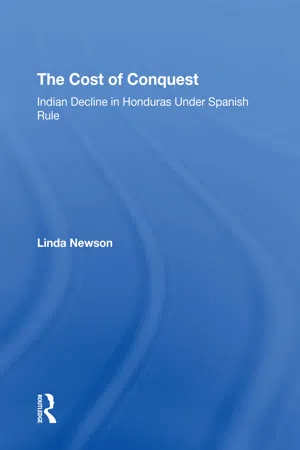
The Cost Of Conquest
Indian Decline In Honduras Under Spanish Rule
Linda Newson
- 378 pages
- English
- ePUB (mobile friendly)
- Available on iOS & Android
The Cost Of Conquest
Indian Decline In Honduras Under Spanish Rule
Linda Newson
About This Book
At the time of the Spanish conquest, Honduras was inhabited by two distinct social systems, which defined the boundary between the cultures of Mesoamerica and South America. Each system was administered in a different way, and subsequently the survival of each civilization varied markedly. This study examines the nature of each culture at the time of Spanish conquest, the size of the populations, and the method of colonization applied to each. Particular attention is focused on Spanish economic activities and the institutions that directly affected the Indian way of life. Dr. Newson bases her findings on extensive archival research conducted in Spain, Guatemala, and Honduras and on archaeological, ethnographic, and linguistic evidence found in secondary sources.
Frequently asked questions
Information
Part I Introduction

1 Patterns of Conquest and Indian Populations
DEMOGRAPHIC PATTERNS IN CENTRAL AMERICA
FACTORS INFLUENCING DEMOGRAPHIC CHANGE
Table of contents
- Cover
- Half Title
- Series
- Title
- Copyright
- Contents
- List of Tables
- List of Figures
- Abbreviations
- Part I Introduction
- Part II Honduras on the Eve of Spanish Conquest
- Part III Spanish Conquest, 1522 to 1550
- Part IV Western and Central Honduras, 1550 to 1821
- Part V Eastern Honduras, 1550 to 1821
- Part VI Demographic Change, 1550 to 1821
- Part VII Conclusion
- Glossary
- Bibliography
- Index
- List of Dellplain Latin American Studies